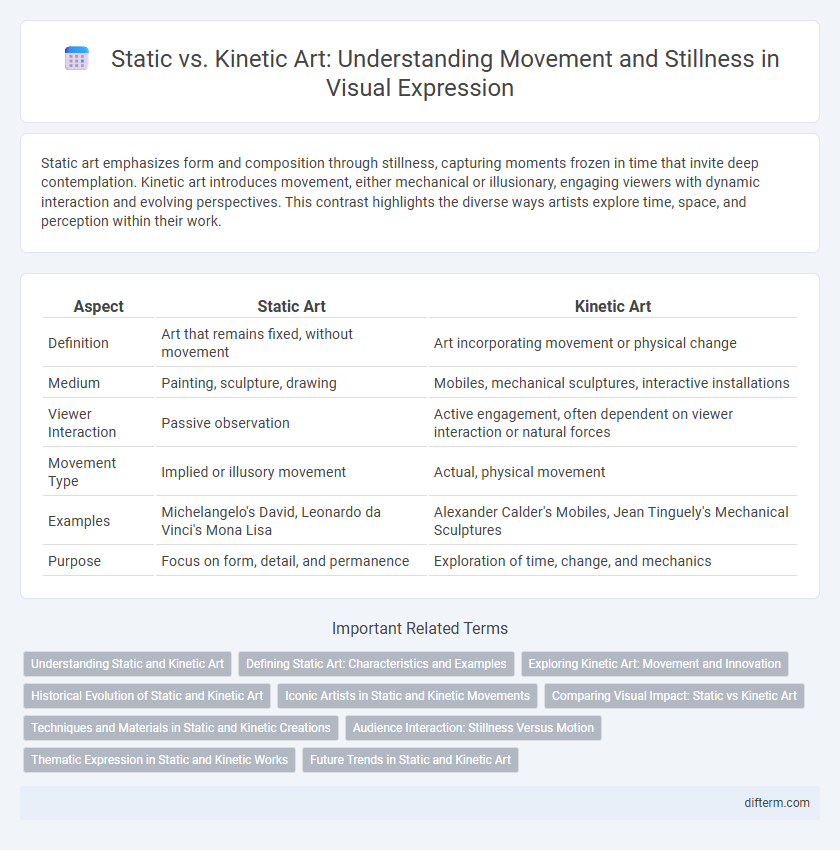Static art emphasizes form and composition through stillness, capturing moments frozen in time that invite deep contemplation. Kinetic art introduces movement, either mechanical or illusionary, engaging viewers with dynamic interaction and evolving perspectives. This contrast highlights the diverse ways artists explore time, space, and perception within their work.
Table of Comparison
| Aspect | Static Art | Kinetic Art |
|---|---|---|
| Definition | Art that remains fixed, without movement | Art incorporating movement or physical change |
| Medium | Painting, sculpture, drawing | Mobiles, mechanical sculptures, interactive installations |
| Viewer Interaction | Passive observation | Active engagement, often dependent on viewer interaction or natural forces |
| Movement Type | Implied or illusory movement | Actual, physical movement |
| Examples | Michelangelo's David, Leonardo da Vinci's Mona Lisa | Alexander Calder's Mobiles, Jean Tinguely's Mechanical Sculptures |
| Purpose | Focus on form, detail, and permanence | Exploration of time, change, and mechanics |
Understanding Static and Kinetic Art
Static art captures a single moment or form, emphasizing stability and permanence through mediums like painting and sculpture. Kinetic art incorporates movement, either real or perceived, engaging viewers by altering its appearance or structure over time. Understanding the distinction enhances appreciation of how artists manipulate space, time, and motion to evoke emotion and meaning.
Defining Static Art: Characteristics and Examples
Static art is characterized by its immobile and fixed form, emphasizing stability, permanence, and often geometric precision. Examples include traditional sculptures, paintings, and architectural works that remain unchanged and invite contemplation of form, color, and texture without movement. This contrast with kinetic art highlights static art's focus on visual harmony and timelessness in capturing artistic expression.
Exploring Kinetic Art: Movement and Innovation
Kinetic art revolutionizes traditional static artworks by incorporating movement, often driven by motors, wind, or viewer interaction, creating a dynamic sensory experience. Artists like Alexander Calder and Jean Tinguely pioneered this genre, blending mechanics with aesthetic innovation to challenge perceptions of time and space within art. By emphasizing motion and change, kinetic art expands the boundaries of artistic expression and invites viewers into an evolving visual dialogue.
Historical Evolution of Static and Kinetic Art
Static art, characterized by fixed, unchanging forms, has origins tracing back to ancient sculptures and classical paintings, emphasizing stability and permanence. The 20th century introduced kinetic art, pioneered by artists like Alexander Calder and Jean Tinguely, incorporating movement and mechanical elements to challenge traditional static concepts. This historical evolution reflects a shift from passive, observer-focused works to dynamic, interactive experiences that engage time and motion as integral artistic components.
Iconic Artists in Static and Kinetic Movements
Iconic artists in the static art movement include Piet Mondrian, renowned for his precise geometric compositions, and Kazimir Malevich, who pioneered Suprematism with his abstract, non-representational forms. In contrast, kinetic art features pioneers like Alexander Calder, famous for his dynamic mobiles that introduce movement into sculpture, and Jean Tinguely, whose mechanical machines challenge traditional notions of static art. These artists exemplify the core principles of static and kinetic art by either emphasizing stillness and spatial balance or integrating motion and change into their works.
Comparing Visual Impact: Static vs Kinetic Art
Static art captivates viewers through fixed compositions and deliberate use of color, form, and texture, offering a contemplative experience rooted in stillness. Kinetic art introduces movement, either real or perceived, engaging audiences with dynamic changes in light, shadow, and perspective that evoke a sense of energy and temporal flow. The visual impact of static works emphasizes permanence and detailed observation, whereas kinetic pieces create immersive environments that transform continuously, blurring the boundaries between art and motion.
Techniques and Materials in Static and Kinetic Creations
Static art techniques emphasize traditional materials such as marble, bronze, and canvas, employing carving, casting, and painting to create fixed, enduring forms. Kinetic art integrates mechanics, motors, and electronic components with flexible materials like metal, plastic, and fabric to produce dynamic, moving sculptures and installations. The fusion of these materials and techniques enables kinetic works to interact with their environment, contrasting the immobile permanence of static creations.
Audience Interaction: Stillness Versus Motion
Static art captivates audiences through stillness, encouraging prolonged contemplation and emotional reflection. Kinetic art engages viewers dynamically, inviting interaction through movement and changing perspectives that transform the experience over time. The contrast between static and kinetic artworks highlights how motion alters audience perception and deepens the connection with the piece.
Thematic Expression in Static and Kinetic Works
Static artworks emphasize thematic expression through visual symbolism and composition, creating a fixed moment that invites contemplation. Kinetic pieces incorporate motion, allowing themes to evolve dynamically and engage viewers in an interactive experience. The contrast highlights how static art conveys meaning via stillness, while kinetic art uses movement to depict change and temporality.
Future Trends in Static and Kinetic Art
Future trends in static and kinetic art emphasize the fusion of digital technology and interactive elements, enhancing viewer engagement through augmented reality and responsive sensors. Artists are increasingly exploring sustainable materials and energy-efficient mechanisms to create environmentally conscious kinetic sculptures. The integration of AI-driven motion and programmable systems is anticipated to transform static artworks into dynamic, evolving installations that challenge traditional boundaries.
Static vs Kinetic Infographic

 difterm.com
difterm.com